Telecommunication in Bangladesh Market Size
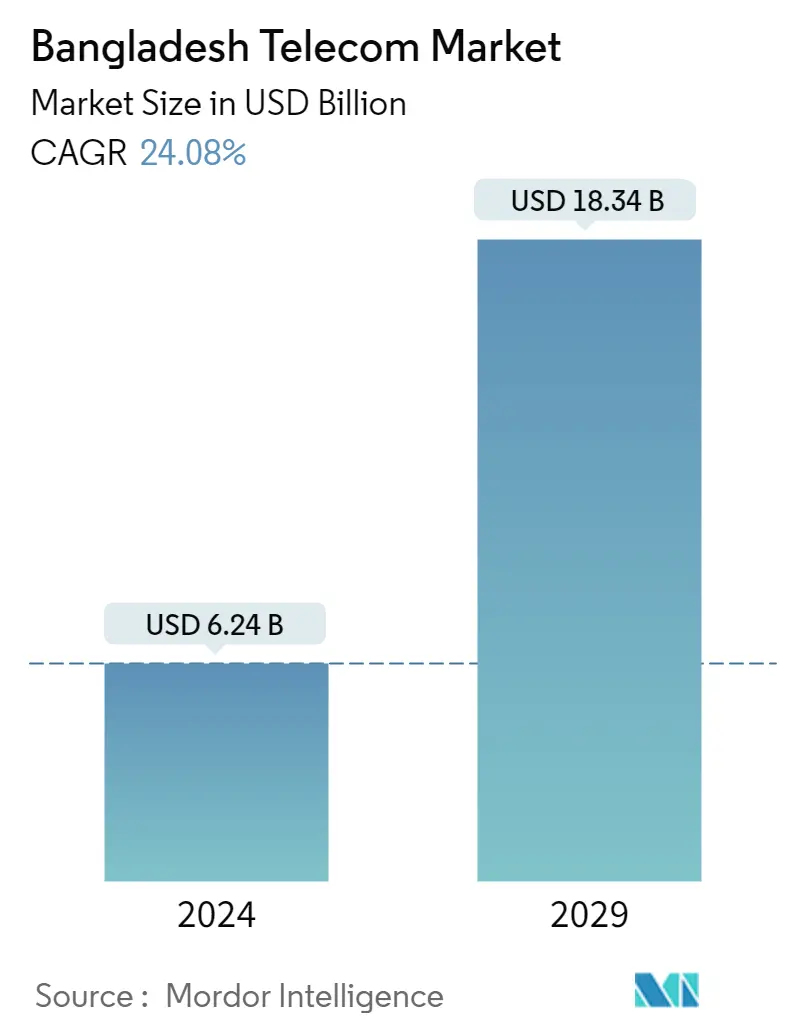
| Study Period | 2018 - 2028 |
| Base Year For Estimation | 2021 |
| Market Size (2023) | USD 5.03 Billion |
| Market Size (2028) | USD 14.78 Billion |
| CAGR (2023 - 2028) | 24.08 % |
| Market Concentration | Low |
Major Players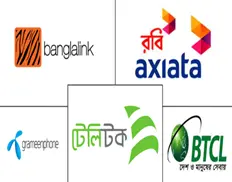
*Disclaimer: Major Players sorted in no particular order |
Need a report that reflects how COVID-19 has impacted this market and its growth?
Telecommunication in Bangladesh Market Analysis
The Bangladesh Telecom Market size is expected to grow from USD 5.03 billion in 2023 to USD 14.78 billion by 2028, at a CAGR of 24.08% during the forecast period (2023-2028).
While voice communication on mobile devices in Bangladesh has been crucial to the growth of the telecom industry, recent developments have seen a change in favor of digital inclusion. The key players in the industry include Banglalink Digital Communications Ltd, Robi Axiata Limited, Grameen Phone Ltd, Teletalk Bangladesh Limited DBA Teletalk, and Bangladesh Telecommunications Company Limited (BTCL).
- The number of mobile data customers in Bangladesh is increasing due to the variety of online activities and the growing popularity of mobile internet services. GSMA report predicts that Bangladesh's smartphone adoption rate will rise from 47% in 2021 to 63% by the end of 2025. According to the research titled "The Mobile Economy Asia Pacific 2022," Bangladesh's subscriber penetration rate will increase to 59% by the end of 2025 from 55% in 2021.
- As per a Financial Express report, The Ministry of Posts and Telecommunications in Bangladesh stated that rather than a blanket activation of the fifth-generation network, the country would implement the 5G network in stages and locations as needed. If Bangladesh connects to the third underwater cable, it is expected to receive 13,200 Gbps (gigabits per second) of capacity (S-MIM-UE-6).
- With the ambition of realization of "Vision 2041," Bangladesh is expanding quickly. Bangladesh's perspective plan aspires to elevate the nation to upper-middle-income level by 2031 and high-income status by 2041. The internet and digital technologies are anticipated to be the essential instruments for carrying out the strategy. Access to inexpensive and dependable connections is important to the government's goal of realizing its "Vision 2041," making digital inclusion a crucial part of this journey.
- The government's realistic choice to postpone the launch and rollout of 5G is noteworthy, given the low usage of 5G in Bangladesh. In the short to medium term, investing in 5G would not be profitable for the nation or the corporations involved. Even though there aren't enough business cases to support it, operators would nonetheless like to implement 5G just to gain from being early adopters and for competitive reasons. The necessity of 5G for Bangladesh to meet its 2041 objective cannot be disputed. The massive investment required, the state of the environment, and the currency reserve limits, however, considerably outweigh the intended advantages. Thus, it might not be considered immediately.
- Connectivity has become essential for the continuance of economic and social activity in Bangladesh after the COVID-19 pandemic. Telecommunication is essential in the country for enabling companies and educational institutions to continue to be active and offer people a way to socialize, work, and access a variety of life-improving services provided. Mobile service providers in Bangladesh have responded to the difficulties caused by the pandemic by taking steps to guarantee that mobile technology is used successfully to maintain a normal life.
Telecommunication in Bangladesh Market Trends
This section covers the major market trends shaping the Bangladesh Telecom Market according to our research experts:
Growth of Mobile Penetration in Bangladesh
- While the demand for smartphones is slowly declining internationally, Bangladesh's mobile phone industry is still strong and has the potential for manufacturers to develop sustainably. In Bangladesh, smartphones are proven to be an essential medium for enabling the digital world. The last ten years have seen a dramatic shift in consumer needs. These years have seen a rise in the demand for high-specification gadgets due to the rapid adoption of smartphones.
- The mobile market in Bangladesh has proliferated over the last ten years. According to a GSMA report, the number of unique users rose to 90 million in 2020 from 47 million in 2010 (an increase of over 90%). By the end of last year, Bangladesh had a penetration rate of 54% for unique subscribers and 101% for all connections, with some users holding multiple connections.
- Mobile connectivity positively affects the country's GDP and productivity. Millions of people use their mobile devices as their main method of internet access. The mobile industry delivers life-improving advantages, including access to educational institutions and financial services. Agricultural production may be increased with the use of mobile services. Through SMS, data, and voice services, mobile devices may offer farmers useful information on crop pricing across markets, weather forecasts, and agronomic guidance. IoT communication between sensors and drones optimizes manufacturing procedures and growth environments.
- Furthermore, with the rising dependence on mobile phones and internet access, the number of mobile phone connections has been growing by more than 10 million in the most recent last calendar year, the highest in three years. According to data from the Bangladesh Telecommunication Regulatory Commission, there were around 181 million active mobile phone connections at the end of December 2021 compared to 170.1 million a year earlier. The total active mobile phone connections of four major mobile phone providers grew by 10.9 million in 2021.
- Following the COVID-19 pandemic, mobile phone operators confirmed that the use of mobile phones and internet-enabled services had reached a new dimension. Tech-savvy individuals conduct daily tasks based on mobile phone connections, including making phone calls and taking part in meetings. There are more than 180 million mobile phone connections, which is about the same as the country's total population. More new connections are expected as the nation enters the age of the internet of things. The launch of fifth-generation, or 5G, mobile phone services might speed up the growth of mobile phone connections across the nation.
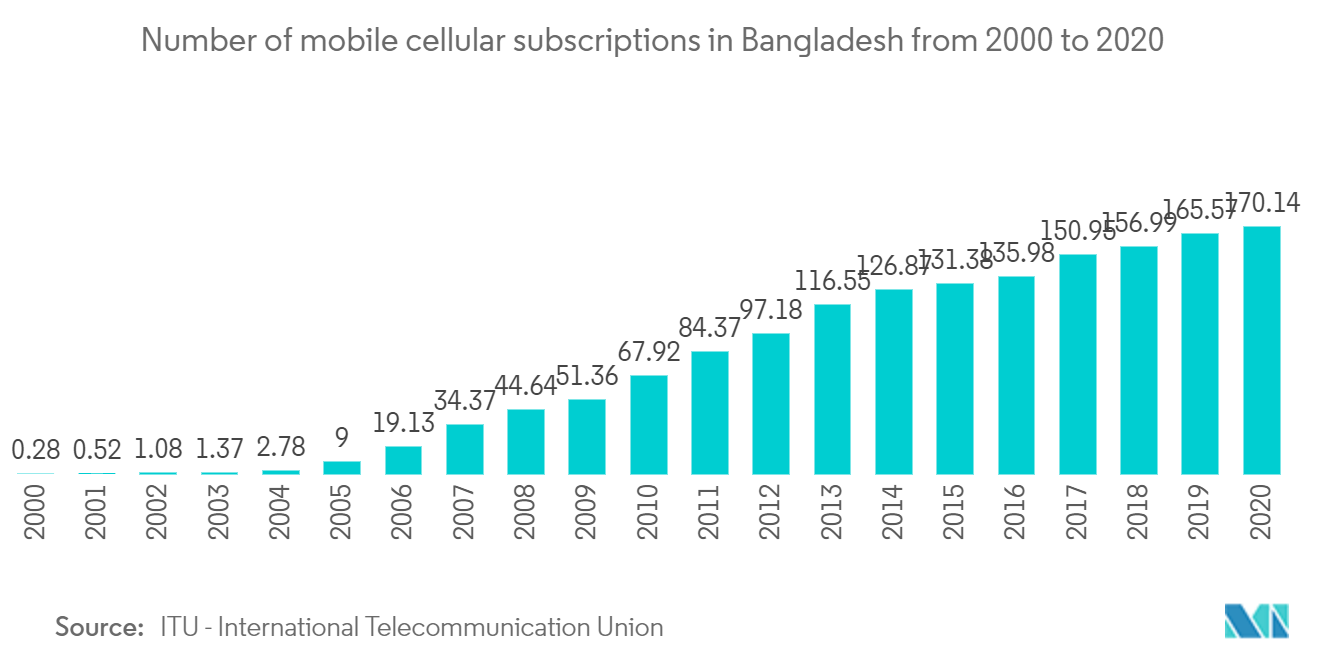
5G would boost wireless segment
- Innovation is at the center of Bangladesh's socioeconomic change. The government is presently pushed by the Digital and Smart Bangladesh programs to transform the country into a high-income nation in line with Vision 2041. Given the government's initiatives to improve environmental sustainability in crucial sectors, Bangladesh is becoming greener thanks to ground-breaking initiatives like developing a smart education system, telemedicine advancements, and financial services digitization, as well as promoting remote work collaboration (over physical ones, unless necessary). In addition to these activities, Bangladesh is also preparing for the future of 5G and the convergence of fixed and wireless networks.
- Following the government's decision to prioritize decreasing and increasing countrywide 4G network coverage to address current connection gaps, fifth-generation (5G) spectrums have been auctioned and are ready for implementation. The advancement of the crucial sectors of government operations and commercial and industrial zones will be given top attention as Bangladesh rolls out 5G in phases.
- Bangladesh is evolving quickly as "Vision 2041" becomes a reality. Bangladesh's perspective plan has a goal of becoming an upper-middle-income nation by 2031 and a high-income nation by 2041. The plan would be implemented mostly through the internet and digital technologies. Digital inclusion is an important part of this journey, and the dependable and inexpensive connection is necessary for the government to achieve its "Vision 2041" goals.
- The fifth generation (5G) era of telecommunications is steadily arriving in Bangladesh. Faster download speeds, low latency, increased connectivity for billions of devices, improvements in virtual reality, the internet of things, and artificial intelligence are just a few things 5G can provide in the country. These advancements can potentially change the entire lifestyle of people across the country. Innovative healthcare, modernized mining, and improved logistics would all emerge from its utilization.
- As confirmed by the officials of the planning ministry, the Bangladesh government finally moved forward with the rollout of fifth-generation (5G) mobile internet services via state-run network provider Teletalk. In the initial days, the 5G network is expected to only be accessible at important governmental and commercial institutions run by the two Dhaka municipal corporations. According to the initiative, Teletalk would get a total of BDT 2365.4 million (USD 23.29 million) from the government to help it adapt its current cellular network to introduce 5G services by 2023. The initiative, which was started by the Posts and Telecommunications Division, hopes to offer 5G-based mobile services to the public by the end of 2023.
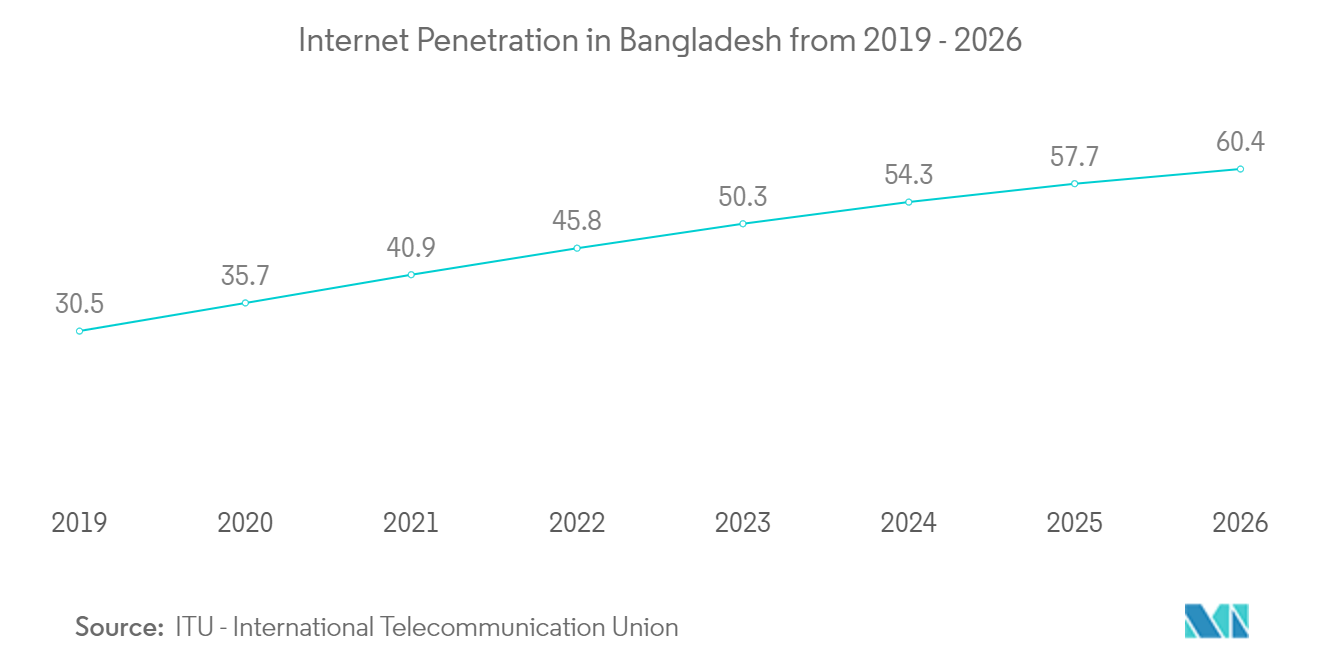
Telecommunication in Bangladesh Industry Overview
The Bangladeshi telecom market is moderately fragmented in nature. Some major players in the market studied include Banglalink Digital Communications Ltd, Robi Axiata Limited, Grameen Phone Ltd, Teletalk Bangladesh Limited DBA Teletalk, and Bangladesh Telecommunications Company Limited (BTCL). The market also hosts other internet service providers (ISPs), MVNOs, and fixed-line service providers. Some of the telecommunication companies in Bangladesh are competitive internationally and hold strong ground in the global telecom space.
- In March 2022, Banglalink, one of the market-leading telecom companies in Bangladesh, announced the launch of Health Hub to establish the nation's first digital health aggregation platform in Bangladesh. Banglalink's Heath Hub is being developed to improve the lives of its users by offering world-class digital services.
- In June 2022, Robi Axiata Limited launched a new digital brand called "Robi for Business" for its enterprise business clients. A hotel in Dhaka recently hosted the brand reveal ceremony. The all-new brand would enable Robi's enterprise customers to digitalize their company operations and obtain cutting-edge digital solutions.
Telecommunication in Bangladesh Market Leaders
Banglalink Digital Communications Ltd.
Robi Axiata Limited
Grameen Phone Ltd.
Teletalk Bangladesh Limited DBA Teletalk
Bangladesh Telecommunications Company Limited (BTCL)
*Disclaimer: Major Players sorted in no particular order
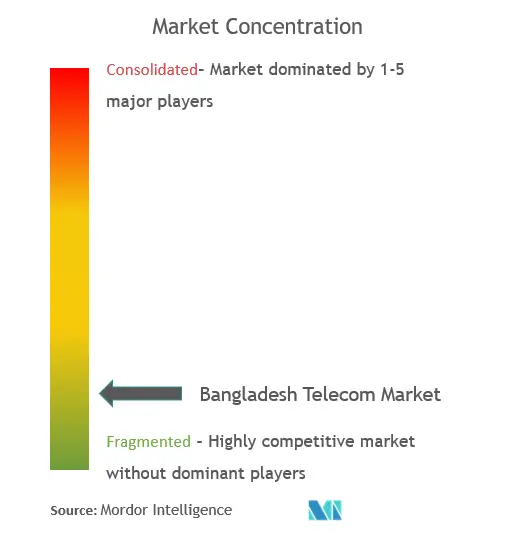
Telecommunication in Bangladesh Market News
- September 2022: Grameenphone began 5G trials in all divisional cities to escalate the transition of "Smart Bangladesh." On July 26, 2022, Grameenphone carried out the nation's first 5G trial run with a few use cases in Dhaka and Chattogram.
- August 2022: Robi Axiata Limited unveiled a collaboration with Prime Bank to provide Robi's clients, distributors, and retailers with its cutting-edge digital services and solutions. The advanced digital services are provided to Robi's final recipients through a virtual event.
Telecommunication in Bangladesh Market Report - Table of Contents
1. INTRODUCTION
1.1 Study Assumptions and Market Definition
1.2 Scope of the Study
2. RESEARCH METHODOLOGY
3. EXECUTIVE SUMMARY
4. MARKET INSIGHTS
4.1 Market Overview
4.2 Industry Ecosystem Analysis
4.3 Industry Attractiveness - Porter's Five Force Analysis
4.3.1 Bargaining Power of Suppliers
4.3.2 Bargaining Power of Consumers
4.3.3 Threat of New Entrants
4.3.4 Threat of Substitute Products
4.3.5 Intensity of Competitive Rivalry
4.4 COVID-19 Impact on the Industry Ecosystem
4.5 Regulatory Landscape in the Country
5. MARKET DYNAMICS
5.1 Market Drivers
5.1.1 Robust Mobile Phone Penetration
5.1.2 Digital Transformation Aiding Growth
5.2 Market Restraints
5.2.1 Delays Relating to 5G Implementation
5.3 Analysis of the Market based on Connectivity (Coverage to Include In-depth Trend Analysis)
5.3.1 Fixed Network
5.3.1.1 Broadband (Cable Modem, Wireline-Fiber, Wireline DSL, Fixed Wi-Fi and Trends Regarding ADSL/VDSL, FTTP/B, Cable Modem, FWA, and 5G FWA)
5.3.1.2 Narrowband
5.3.2 Mobile Network
5.3.2.1 Smartphone and Mobile Penetration
5.3.2.2 Mobile Broadband
5.3.2.3 2G, 3G, 4G, and 5G Connections
5.3.2.4 Smart Home IoT and M2M Connections
5.4 Analysis of Telecom Towers (Coverage to Include In-depth Trend Analysis of Various Types of Towers, like Lattice, Guyed, Monopole, and Stealth Towers)
6. MARKET SEGMENTATION
6.1 Segmentation by Services (Coverage to Include Average Revenue Per User for the Overall Services Segment, Market Size and Estimates for Each Segment, and In-depth Trend Analysis)
6.1.1 Voice Services
6.1.1.1 Wired
6.1.1.2 Wireless
6.1.2 Data and Messaging Services (Coverage to include Internet & Handset Data packages, Package Discounts)
6.1.3 OTT and PayTV Services
7. COMPETITIVE LANDSCAPE
7.1 Company Profiles
7.1.1 Banglalink Digital Communications Ltd
7.1.2 Robi Axiata Limited
7.1.3 Grameen Phone Ltd
7.1.4 Teletalk Bangladesh Limited DBA Teletalk
7.1.5 Bangladesh Telecommunications Company Limited (BTCL)
7.1.6 Pacific Bangladesh Telecom Limited
7.1.7 Banglalion Communications Ltd
7.1.8 GETCO Telecommunications Ltd
7.1.9 IDEA Networks and Communications Limited
7.1.10 Ranks Telecom Ltd
- *List Not Exhaustive
8. INVESTMENT ANALYSIS
9. MARKET OPPORTUNITIES AND FUTURE TRENDS
Telecommunication in Bangladesh Industry Segmentation
Telecom or telecommunication is the long-range transmission of information by electromagnetic means. The study on the Bangladeshi telecom market includes an in-depth trend analysis based on connectivity like fixed networks, mobile networks, and telecom towers.
The telecom services are divided into voice services (wired and wireless), data and messaging services, and OTT and payTV services. The adoption of telecom services is likely driven by several factors, including an increasing demand for 5G. The market sizes and forecasts are provided in terms of value (in USD million) for all the above segments.
| Segmentation by Services (Coverage to Include Average Revenue Per User for the Overall Services Segment, Market Size and Estimates for Each Segment, and In-depth Trend Analysis) | ||||
| ||||
| Data and Messaging Services (Coverage to include Internet & Handset Data packages, Package Discounts) | ||||
| OTT and PayTV Services |
Telecommunication in Bangladesh Market Research FAQs
How big is the Bangladesh Telecom Market?
The Bangladesh Telecom Market size is expected to reach USD 5.03 billion in 2023 and grow at a CAGR of 24.08% to reach USD 14.78 billion by 2028.
What is the current Bangladesh Telecom Market size?
In 2023, the Bangladesh Telecom Market size is expected to reach USD 5.03 billion.
Who are the key players in Bangladesh Telecom Market?
Banglalink Digital Communications Ltd., Robi Axiata Limited, Grameen Phone Ltd., Teletalk Bangladesh Limited DBA Teletalk and Bangladesh Telecommunications Company Limited (BTCL) are the major companies operating in the Bangladesh Telecom Market.
Telecommunication in Bangladesh Industry Report
Statistics for the 2023 Telecommunication in Bangladesh market share, size and revenue growth rate, created by Mordor Intelligence™ Industry Reports. Telecommunication in Bangladesh analysis includes a market forecast outlook to 2028 and historical overview. Get a sample of this industry analysis as a free report PDF download.
